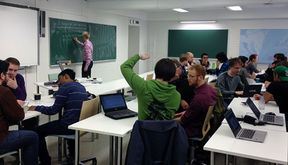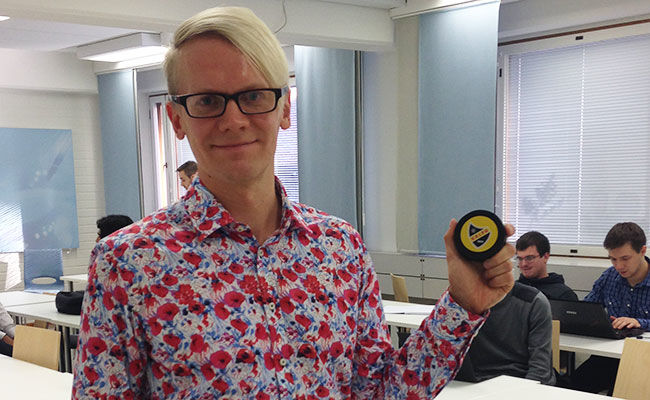A statistics-gathering antenna designed for ice hockey

An antenna was installed inside a hockey puck that utilises Quuppa’s system by collecting data during the game. The position of the puck is measured with this system, and for the purpose of measurement it is necessary to install a Bluetooth radio transmitter that requires an antenna inside the puck. This antenna was designed during the Antennas Workshop course.
‘The idea of the course ensued from a meeting with a stakeholder. I asked Quuppa’s managing director, Kimmo Kalliola, whether it would be possible for their enterprise to design, together with the students, some sort of product,’ university lecturer Jari Holopainen, course instructor, related.
The course was implemented in this format for the very first time.
‘The course has no ready-existent right answers; rather, the students are given various themes to work with. The students themselves define the problem and work together to find good solutions,’ Mr Holopainen stated with regard to the course aims.
A puck that collects statistics improves the customer experience
Quuppa, with its team of nine employees, is a company which designs real-time locating systems for indoor spaces. Locating systems provide precise data for a variety of sports. This precision is achieved using high-quality algorithms.
Managing Director Kimmo Kalliola, who personally graduated from Aalto University School of Electrical Engineering / Department of Electronics and Nanoengineering, related that they have prototypes available for the product concerned. For the time being, however, the prototypes of the antenni measuring the hockey puck are not ready for mass production.
‘We are seeking an actual solution to this problem, since our services are being used considerably in sports-related statistics gathering. At the moment, we’re able to position sensors in the players' shoulder pads, which enables us to collect data about the game. This data would, of course, be more precise and better able to serve our clients if we could obtain it not only from the players but also from the puck itself,’ Mr Kalliola asserts, summing up the task.
'When more data is available about the game, it will be possible with the help of this data-collecting puck to enrich the experience of the players and the viewers alike.’
Students tackle the problem with enthusiasm
At the end of the first lecture, the students considered the task in small groups. Many good points and observations were made.
For example, the following matters were considered: How does the positioning of the antenna inside the puck affect its movement on the ice? What is the lifespan of an antenna? How long does it last out in punishing game conditions? Is it possible to replace the material around the antenna with something equivalent, which simulates the real puck material, so that the puck would behave in the best possible way?
Finding a solution was challenging owing to the fact that, for instance, it is difficult to get the antenna to operate effectively inside the puck through the rubber material concerned. The internal positioning must also be such that it remains in position in the fast-moving puck: During a match the puck can reach speeds of over 170 km/h. In addition, the small size of the puck also makes it difficult to install an antenna inside it.
As the course progressed, answers to all these questions were found. The final solutions were presented in December in the concluding seminar.
Text and photographs: Annika Artimo
